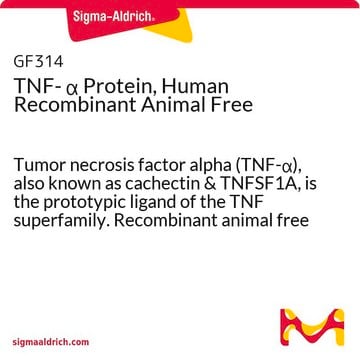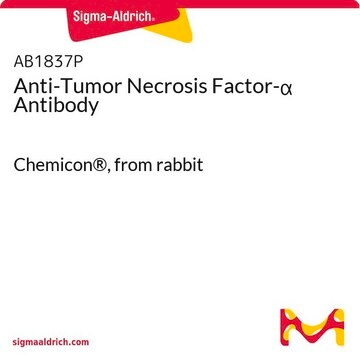推荐产品
生物源
human
重組細胞
expressed in E. coli
化驗
≥98% (HPLC)
≥98% (SDS-PAGE)
形狀
lyophilized
效力
0.25 ng/mL ED50
分子量
18.3 kDa
包裝
pkg of 20 μg
技術
cell culture | mammalian: suitable
雜質
<0.1 EU/μg endotoxin, tested
顏色
white
UniProt登錄號
運輸包裝
wet ice
儲存溫度
−20°C
基因資訊
human ... TNFRSF1A(7132)
一般說明
TNFR1 (tumor necrosis factor receptor 1) gene is localized to human chromosome 12p13, and encodes a 55kDa receptor showing a wide range of tissue expression. This receptor belongs to the family of receptors which contain repeating cysteine-rich extracellular motifs. TNFR1 contains a protein-protein interacting domain called death domain containing ∼70 amino acids. It also contains a silencer of death domains (SODD), a 60kDa domain, which inhibits ligand-independent self-association of TNFR1. TNFR1 is a member of the TNFR family, which are type I transmembrane proteins.
Recombinant human sTNFR1 is an 18.3 kDa protein (162 amino acid residues) comprising the cysteine rich ligand binding portion of the extracellular domain of the TNFR1 protein.
Recombinant human sTNFR1 is an 18.3 kDa protein (162 amino acid residues) comprising the cysteine rich ligand binding portion of the extracellular domain of the TNFR1 protein.
生化/生理作用
TNFR1 (tumor necrosis factor receptor 1) is involved in inflammatory responses, and the cleavage of the membrane form leads to production of soluble TNFR1. The soluble form competes with the membrane-bound form, and this leads to a reduction in the severity of the inflammatory responses. Mutations in this gene resulting in the disruption of conserved extracellular disulfide bonds, leads to lower levels of soluble TNFR1 forms, which is linked with autosomal dominant periodic fever syndromes, characterized by unexplained recurrent fevers and severe localized inflammation. Studies in two independent community-based elderly cohorts show that sTNFR1 is linked with increased mortality in cardiovascular and cancer cases.
序列
MDSVCPQGKY IHPQNNSICC TKCHKGTYLY NDCPGPGQDT DCRECESGSF TASENHLRHC LSCSKCRKEM GQVEISSCTV DRDTVCGCRK NQYRHYWSEN LFQCFNCSLC LNGTVHLSCQ EKQNTVCTCH AGFFLRENEC VSCSNCKKSL ECTKLCLPQI EN
外觀
Lyophilized from 10 mM Tris, pH 8.0 + 20 mM NaCl.
重構
Centrifuge the vial prior to opening. Reconstitute in water to a concentration of 0.1-1.0 mg/ml. Do not vortex. This solution can be stored at 2-8°C for up to 1 week. For extended storage, it is recommended to further dilute in a buffer containing a carrier protein (example 0.1% BSA) and store in working aliquots at -20°C to -80°C.
儲存類別代碼
11 - Combustible Solids
水污染物質分類(WGK)
WGK 3
閃點(°F)
Not applicable
閃點(°C)
Not applicable
Soluble tumor necrosis factor receptor 1 (sTNFR1) is associated with increased total mortality due to cancer and cardiovascular causes - findings from two community based cohorts of elderly.
Carlsson AC et al
Atherosclerosis, 237(1), 236-242 (2014)
Signalling pathways of the TNF superfamily: a double-edged sword.
Aggarwal BB
Nature Reviews: Immunology, 3(9), 745-756 (2003)
Germline mutations in the extracellular domains of the 55 kDa TNF receptor, TNFR1, define a family of dominantly inherited autoinflammatory syndromes.
McDermott MF et al
Cell, 97(1), 133-144 (1999)
Aggarwal, B.B., et al.
Cytokine Reference, 1619-1632 (2001)
我们的科学家团队拥有各种研究领域经验,包括生命科学、材料科学、化学合成、色谱、分析及许多其他领域.
联系技术服务部门






